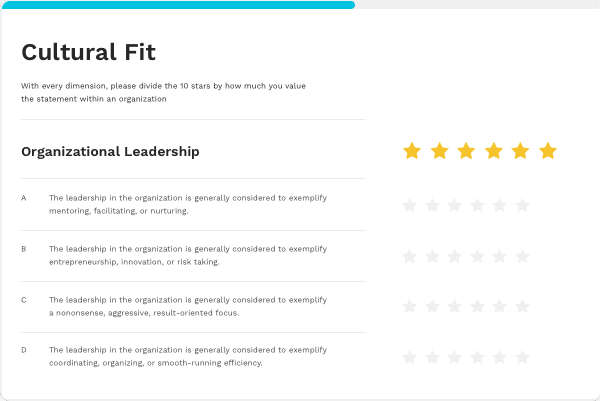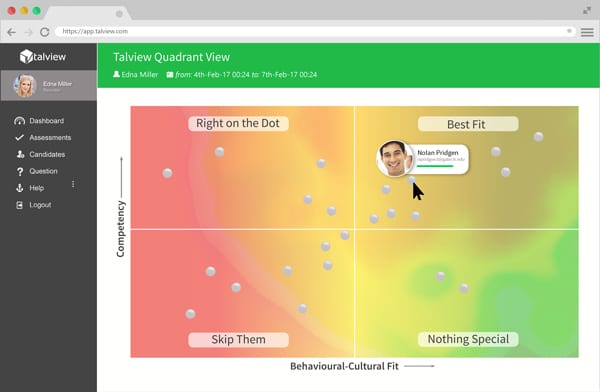Using technology to hire for cultural fit may sound counterintuitive, but it's your best bet to remove ambiguity from the process.

What factor do job seekers value in their next job more than any other, besides salary? Cultural fit.
What did an oft- and still-cited meta-analysis find contributes to higher job satisfaction, job performance, and employee retention? Cultural fit.
What Boy George-led band vaulted to the top of the charts in 1984 with “Karma Chameleon"? Culture Club.
What I'm trying to say is that hiring for cultural fit is vital to the success of your organization. A lot of recruiters know this, but that doesn't make the process of determining what cultural fit actually means (and assessing candidates against that determination) any easier.
Because hiring for cultural fit is so open to interpretation (try getting a team to objectively rank job candidates on a trait like passion to see what I mean) and is influenced by personal preference and gut instinct, the process is fraught with peril. Bad hires happen often, and hiring managers can misinterpret cultural fit as “someone like me"—stifling diversity and inclusion efforts.
How do we fix this? We abandon the idea that we can't codify cultural fit.
We can and we should codify it because the likelihood of making a successful cultural fit hire increases dramatically when the process behind that decision is codified and data-driven.
And this is where the right recruiting software can be tremendously beneficial.
3 ways software improves hiring for cultural fit
Let's take a look at three ways the right recruiting software can help your business successfully hire for cultural fit.
1. Cultural fit assessments standardize and quantify cultural alignment
If you diagnosed the causes of poor cultural fit hiring in your organization, you'd likely find two major culprits:
Recruiters and hiring managers who are misaligned on what traits constitute a cultural fit.
An over-reliance on poor instruments such as resumes or interviews that can't accurately measure job candidates for different cultural fit traits.
Cultural fit assessments solve both of these problems.
First, these tools ask companies to focus internally and have current workers from different teams take the assessment. Some assessments will ask employees for their feelings or preferences when it comes to work, while others pose hypothetical situations where employees choose how they would act.

An example of a cultural fit assessment question in Harver (Source)
The software then does the dirty work of quantifying your culture based on these responses, making it abundantly clear to everyone involved in the hiring process what cultural fit actually means for various teams in your organization.
As job candidates come in, they take the same assessment. Their results are then compared to those of the team they applied for to determine how well they align.

Assessing cultural alignment in ThriveMap (Source)
These tools not only quantify and visualize cultural fit in a standardized way, but also offer better apples-to-apples comparisons of your different candidates—making hiring decisions easier.
Compare popular cultural fit assessment tools
2. Predictive hiring platforms make data-backed cultural fit recommendations
You can't yet peer into a crystal ball and see if your hiring decisions work out or not, but predictive hiring platforms can get you close.
These tools work by gathering as many data points on current and past employees as possible. These data points can come from resumes or cultural fit assessments, or a variety of other sources such as:
Social media profiles
Blogs
Professional contributions to online forums
Your HRIS or performance management system
A predictive analytics model is then applied to the data to determine which data points correlate best with worker success (most often pinned to retention). This step can take time as different models are applied, and more data is gathered to test for each model's accuracy.
Once an accurate model is found, the predictive hiring platform can then analyze the same data points from job applicants and automatically rank the best candidates based on their likelihood to succeed.

Plotting candidates based on predictive success in Talview ([_Source](https://www.capterra.com/p/142374/Talview/))_
Do these platforms require a lot of data to make accurate predictions? Yes. Can they be just as biased in their hiring decisions as humans if you're not careful? Also yes.
When handled correctly, however, predictive hiring platforms offer a marriage of AI and data science that can drastically improve cultural fit hiring outcomes over time.
Find a predictive hiring platform that best fits your needs
3. Employee referral portals empower your culture captains
Again and again, employee referrals have proved to be the best source for quality hires. After all, who knows who would succeed at your company and fit in with your culture better than your own employees?
The only problem is nearly half of all employees don't participate in employee referral programs. If this sounds like your organization, stop relying on errant emails or bulletin boards to remind workers to refer friends and colleagues, and upgrade to a recruiting system with an employee referral portal.
Using these systems, recruiters can set monetary referral rewards for different positions, depending on the scarcity of talent for the role or how quickly the position needs to be filled. Employees can then log in to the portal and see these reward amounts. If an employee's referral is hired and sticks around for a predetermined amount of time, that employee gets the reward.
Within the portal, employees can also check the status of their referrals and share job listings on their social networks—encouraging worker participation.

Sharing internal job listings on social networks in Avature Employee Referrals (Source)
These employee-facing portals are becoming increasingly common in recruiting systems, and perform the dual duty of making it easier for workers to refer people, and easier for HR to set, track, and disperse referral rewards. They're vital to cultural fit hiring success.
Read reviews of leading employee referral portal systems
Is cultural fit losing its human touch?
With additions like cultural fit assessments, predictive hiring capabilities, and employee referral portals, recruiting software systems are increasingly providing the technology needed to aid in cultural fit hiring decisions.
With this change comes uncertainty. Are interviews archaic? Is gut instinct on a candidate useless? The answer to both questions is no. These tools are meant to augment your processes, not replace them. In the end, your hiring decision should ultimately be a human one.